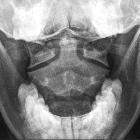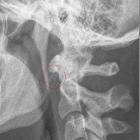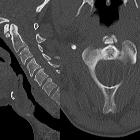Anomalien des kraniozervikalen Übergangs

Processus
epitransversarius rechts, nicht mit dem Processus transversus verschmolzen, somit eher Os epitransversarium.

Einseitig
ausgebildeter Processus epitransversarius des Atlas, der pseudarthrosenähnlich mit einem Processus paracondylicus vom Hinterhaupt in Verbindung steht. Zufallsbefund bei einem jungen Mann. Computertomographie links als Volumen-rendering, rechts als koronare Rekonstruktion.

Os
epitransversarium links als gesondertes Ossikeln oberhalb des Processus transversus des Atlas.

Fehlende
Fusion des vorderen und hinteren Atlasbogens: Split-Atlas. Bei der 50-jährigen zeigen sich in der Computertomographie entsprechend schon sekundäre degenerative Veränderungen.

Spalt am
hinteren Atlasbogen bei einem über 70-jährigen. Korrespondierend findet sich im vorderen Bogen eine mediane Sklerosierung. Aber kein echter Split-Atlas.

Processus
paracondylicus links, der mit dem Processus transversus des Atlas eine pseudarthrosenähnliche Verbindung hat. Links coronare Rekonstruktion, rechts Volumen Rendering mit Ansicht von dorsal.

Atlantookzipitale
und atlantoaxiale Fusion mit am ehesten anlagebedingter Verblockung zwischen dem Hinterhaupt, dem ersten und dem zweiten Halswirbel. Computertomografie axial, sagittal und koronar.

Achondroplasia
• Achondroplasia - Ganzer Fall bei Radiopaedia

Craniovertebral
junction anomalies • Atlanto-occipital assimilation with basilar invagination - Ganzer Fall bei Radiopaedia
Craniovertebral junction (CVJ) anomalies can be congenital, developmental or due to malformation secondary to any acquired disease process. These anomalies can lead to cranial nerve compression, vertebral artery compression and obstructive hydrocephalus.
Pathology
The craniovertebral junction is formed by the occipital condyles, atlas (C1), axis (C2) vertebrae and their articulations. Any process which can give rise to malformation of these structures, may result in CVJ anomaly. It can be due to congenital, developmental or acquired cause.
On this basis of etiology, CVJ malformations can be classified as:
Congenital anomalies and malformations
Malformations of the occipital sclerotome
- remnants of proatlas
- platybasia
- occipital condylar hypoplasia
- condylar dysplasia (condylus tertius, paracondylar process, and basilar process)
- segmentation anomaly of the clivus
- atlas assimilation
Malformations of atlas vertebra
- atlas assimilation
- bifid arches
- aplasia and hypoplasia of the atlas
Malformation of axis and odontoid process
- atlantoaxial fusion
- persistent ossiculum terminale
- os odontoideum
- odontoid dysplasia
Developmental and acquired malformations
Malformations at foramen magnum
- basilar invagination
-
paramesial invagination
Atlantoaxial instability
-
infections
trauma
-
inborn errors of metabolism
-
neoplastic
osteofibroma
-
other
Conradi syndrome

 Assoziationen und Differentialdiagnosen zu Anomalien des kraniozervikalen Übergangs:
Assoziationen und Differentialdiagnosen zu Anomalien des kraniozervikalen Übergangs:





